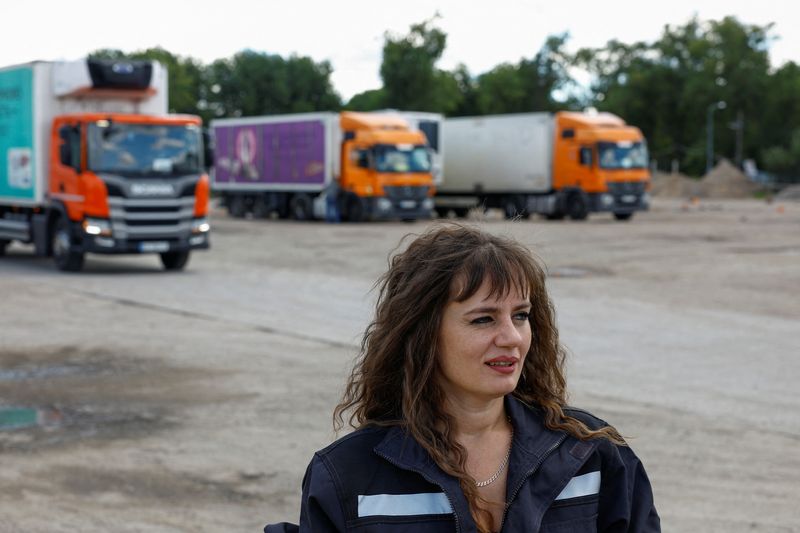Ukraine businesses hire more women and teens as labour shortages bite
2024.09.12 02:58
By Olena Harmash
KYIV (Reuters) – After spending years in what she described as “boring, sedentary” roles in the offices of several Ukrainian companies, Liliia Shulha landed her dream job as a truck driver with Ukraine’s leading retailer, Fozzy Group.
“I always dreamed about big cars. Instead of (playing with) dolls, I drove cars when I was a child,” she told Reuters.
“Now the situation is such that they take people without experience and they train. I was lucky,” said Shulha, 40, wearing a company uniform in front of a large truck.
As the war with Russia drains the labour force, businesses are trying to cover critical shortages by hiring more women in traditionally male-dominated roles and turning to teenagers, students and older workers.
With millions of people, mostly women and children, abroad after fleeing the war, and tens of thousands of men mobilised into the army, the jobs crisis could endanger economic growth and a post-war recovery, analysts say.
Ukraine has lost over a quarter of its workforce since Russia’s invasion in February 2022, central bank data showed.
Nearly 60% of businesses said finding skilled workers was their main challenge, an economy ministry survey of over 3,000 companies showed.
“The situation is indeed critical,” said Tetiana Petruk, chief sustainability officer at steel company Metinvest, one of Ukraine’s largest employers with a workforce of about 45,000. It has about 4,000 vacancies.
“The staff deficit that we feel has an impact on our production,” Petruk told Reuters in an online interview.
“We are not the only ones who feel the staff shortages, all companies in the regions feel that, including our contractors.”
Reuters spoke to representatives of nine Ukrainian companies, from big industrial firms to retail groups and small private entrepreneurs. All said staff shortages and a growing mismatch of skills were big challenges.
Businesses said they were changing recruitment and business practices, automating, rotating existing staff and expanding their job descriptions, re-hiring retirees and offering more benefits, especially for younger workers.
They have also had to increase wages. The average monthly wage is now about 20,000 hryvnias ($470) compared to about 14,500 a year ago.
“There is a noticeable shift away from gender and age bias in candidate selection as employers adjust criteria to attract needed employees,” said the Kyiv School of Economics. “This trend also extends to entrepreneurship, where the share of female entrepreneurs is growing significantly.”
MORE WOMEN
Male-dominated industries are more affected by staff shortages, the central bank said.
The construction sector, transport, mining and others have all suffered because of military mobilisation, for which men aged 25 to 60 are eligible. To keep the economy running, the government provides full or partial deferrals for critical companies.
In the energy and weapons production sectors, 100% of staff are eligible for draft deferral. In some other sectors, firms can retain 50% of male staff. But the process to secure deferral is long and complicated.
As the government toughened mobilisation rules this year, the number of men preferring informal employment – allowing them to stay off public data records – grew, some enterprises said.
In the agricultural southern region of Mykolayiv, women are being trained as tractor drivers. Women are also increasingly working as tram and truck drivers, coal miners, security guards and warehouse workers, companies say.
“We are offering training and jobs for women who have minimal experience,” said Lyubov Ukrainets, human resources director at Silpo, part of Fozzy Group.
Including Shulha, the company has six female truck drivers and is more actively recruiting women for other jobs previously dominated by men, including loaders, meat splitters, packers and security guards.
The share of female employees is growing in industries such as steel production. Petruk said female staff accounted for about 30-35% of Metinvest’s workforce and the company now hired women for some underground jobs. Metinvest was unable to provide comparative figures for before the war.
Some other women are unable or unwilling to join the workforce because of a lack of childcare. Shulha, who works 15-day stretches on the road, has moved back in with her parents to ensure care for her 14-year-old son and 16-year-old daughter.
YOUNG PEOPLE
Businesses and economists expect labour market challenges to persist. Employers are turning their attention to young people by offering training, job experience and targeted benefit packages.
Metinvest, which previously focused on students, is now increasingly working with professional colleges, Petruk said.
Silpo is more actively hiring teenagers for entry-level jobs in supermarkets and has launched a specialised internship programme for students.
Mobile phone operator Vodafone (NASDAQ:) repackaged its youth program, creating an opportunity for about 50 teenagers in 12 cities to get their first job experience.
“We want to offer the first proper experience of the official job to this young audience. Another objective is to build a talent pool,” said Ilona Voloshyna of Vodafone Retail.
“Also we want to understand the youth,” she said in a Vodafone shop in Kyiv as six teenagers consulted with visitors.

The government and foreign partners have launched several programmes to help Ukrainians reskill.
“We provide the opportunity for everyone at state expense to obtain a new profession which is in demand on the labour market, or to raise their professional level,” said Tetiana Berezhna, a deputy economy minister.








